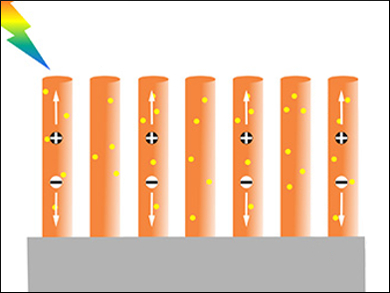Photoelectrochemical (PEC) water splitting is a promising alternative approach for solar hydrogen conversion that requires photoelectrodes with excellent sunlight harvesting and charge transfer abilities. Hematite has emerged as an ideal candidate due to its narrow band gap of 2.1 eV, as well as its abundance and stability. However, its intrinsically poor electrical conductivity and short carrier lifetime lead to poor PEC performance.
Shaohua Shen and colleagues, Xi’an Jiaotong University, China, have produced Nb-doped hematite photoanodes with improved performance. The team prepared α-Fe2O3 nanorod arrays using a mild aqueous solution method with niobium chloride (NbCl5) directly added to the precursor solution, followed by high-temperature annealing.
The optimally doped sample showed a 4-fold photocurrent increase compared with pristine hematite under solar illumination. The researchers attributed this improved performance to the modified electronic structure, which provides a better charge transfer ability, and the small nanorod diameter, which shortens the charge transfer distance.
This work provides a facile strategy for the fabrication of highly efficient PEC cells, and should also be helpful for optimizing doped hematite and other semiconductor materials for different applications.
- Nb-doped Hematite Nanorods for Efficient Solar Water Splitting: Electronic Structure Evolution versus Morphology Alteration,
Yanming Fu, Chung-Li Dong, Wan-Yi Lee, Jie Chen, Penghui Guo, Liang Zhao, Shaohua Shen,
ChemNanoMat 2016.
DOI: 10.1002/cnma.201600024




